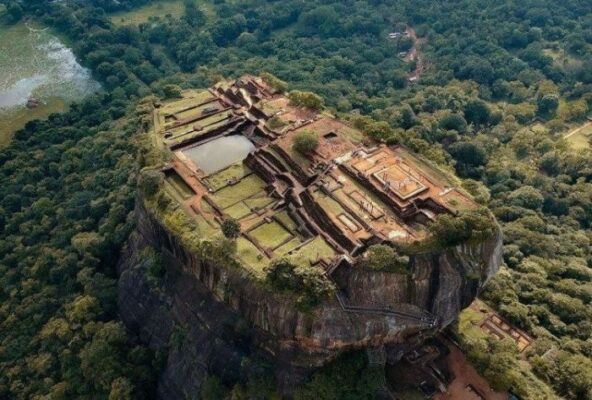The story of The Ramayana or Rama’s Journey- the epic tale of Rama and Sita, is India’s first great Sanskrit poem, composed by the Indian sage Valmiki in 400 AD, who based his epic work on stories, songs and prayers connected to Rama and Sita.
The epic romantic tale of love, spirituality, war and more focused on the dutiful Lord Rama, Prince of Ayodhya, who was exiled from his father’s kingdom for 14 years along with his wife Sita and brother Laxmana. The tale that takes many travellers to Sri Lanka to try to piece together what really happened, is when Sita was abducted by Ravana – the king who was said to reside in Sri Lanka – an act that lead to war, the burning of the capital city of Lankapura, and the besieging of Ravana’s fabled island fortress.
Here is every accessible location you need to visit, on your journey to piecing together this centuries-old love story on your Ramayana Tour.
Table of Contents
1. Chilaw

Munneswaram Temple is considered the oldest Hindu temple dedicated to Lord Shiva in Sri Lanka and the ancient belief is that this is the place where King Rama prayed to Lord Shiva after he slayed Ravana in order to rid of the bad omen or karma (named Brahmahatya Dosha) which he received after he had killed king Ravana who was a Brahmin.
It was said that Lord Shiva had instructed Lord Rama to install four Shivalingas at four different places namely Manavari, Thiru Koneshwaram, Thiru Ketheshwaram and Rameswaram in India to get rid of his ‘Brahmahatya Dosha’. Manavari Temple is the first place where Lord Rama installed the Shivalinga – and is named Ramalingam, to date. It is important to note that Rameswaram in India is the only other lingam in the world named after Lord Rama.
2. Mannar
Thiruketheeswaram is one of the five Sivan temples on the island and is where one of the three Shivalingas (carved out of granite) is installed by Lord Rama in Sri Lanka. Thiruketheeswaram is also believed to be the birthplace of Ravana’s queen Mandodhari.
Ram Sethu or Adam’s bridge is a massive bridge that connects India and Sri Lanka and consists of a string of coral reefs, shoals and shifting sandbanks. According to legend, Rama Sethu, a legendary bridge, is supposed to have been built by Rama with the help of Lord Hanuman and his army to reach Sri Lanka.
3. Trincomalee
According to the legend, it is believed to be the second place where Lord Rama installed the shivalingas.
In addition, visit Kanniya Hot Water Spring – a place believed to be where King Ravana carried out the last rites for his mother. Legend has it that when he was unable to find water to perform the rites, in anger he pierced his Trishula into the ground seven times, and water started gushing out.
4. Kurunegala
Dolukanda is another interesting place in Sri Lanka with strong links to the Indian epic, where it is said to have been one of the five places where Lord Hanuman accidentally dropped a piece of Sanjeevani Mountain (including at Roomassala, Ritigala, Thalladi, and Kachchativu, also known to
be havens for ayurvedic medicines).
5. Sigiriya
A UNESCO World Heritage site, the Sigiriya Rock (Cobra Hood Cave) is a world-famous tourist attraction and is actually a rock fortress with legendary links to the Ramayana story. According to legend Naguliya Cave in Sigiriya is believed to be one of the places where Ravana kept Sita Devi captive in Sri Lanka.
6. Ramboda/ Pussellawa
Sri Baktha Hanuman Temple, built in honour of Lord Hanuman, who on the hills of Ramboda, was searching for Setadevi, and has become a place for special poojas to be held for Lord Hanuman on every full moon day, attracting thousands of devotees.
Chariot Path is a plain area near an estate in Pussellawa seen from the summit of a mountain range. Here many tourists flock to see the imprint of what is known to be Lord Hanuman’s first footstep in Sri Lanka.
In addition, the Sita Tear Pond found nearby, is said to have been formed from Sita Devi’s tears.
The singular most important destination to visit may in fact be Sita Kotuwa, which translates to ‘Sita’s Fort’ in Sita Kotuwa in Sinhala, and is the first place where Sita was supposedly held captive by King Ravana after she was kidnapped. Visitors can witness beautiful waterfalls, streams, and varieties of flora and fauna.
7. Nuwara Eliya
Visit Seetha Amman Temple, built on the sides of a stream where it is believed that Sita Devi bathed. This temple celebrates Lord Rama, Sita Devi, Lakshmana, and Lord Hanuman. Here you will find footprints in both large and small sizes that are said to be Lord Hanuman’s.
Divurumpola Temple is where Sita Devi’s “Agni Pariksha” (a test) by the fire where she proved her innocence and purity to Rama.
Travel a little further out and you come to Sita Eliya, a garden in which Sita stayed under Ravana’s captive; and The Sita Pokunaa – a barren area atop the Hakgala Rock Jungle, where Sita was said to have bathed in a stream.
8. Ella
Ella is another legendary area that boasts two locations allied with the great epic.
Ravana Ella Falls – a breathtaking 1080 feet high waterfall that cascades into several falls, is named after King Ravana and believed that Sita bathed in a pool that gathered the water falling from this waterfall. King Ravana is in fact said to have lived in one of the caves above the waterfall.
In addition, the Ravana Cave & tunnels are said to have been a part of architectural mastery created by King Ravana, acting as a swift means of transport through the hills and also as secret passages.
9. Colombo
Anjaneyar Temple, situated in the capital of Colombo famous as the only temple in the world to own a chariot for Anjaneyar. Dedicated to Lord Hanuman, the Anjaneyar Temple is the first temple in Sri Lanka that depicts his Panchamuga form (five faces) and it is said to be the only temple in the world to have a chariot for Anjaneyar. The chariot festival of this temple is held annually in December or January and is a popular temple festival in Colombo.2
Last on our list of this epic tale is Kelaniya Vibhishana Temple – a sacred place for Buddhists and is said to be where Lakshmana crowned Vibhishana as the Sri Lankan ruler after the demise of King Ravana. The crowning of Vibhishana is depicted through beautiful murals found outside the Buddhist temple.
And so from art to the historical landscapes of Sri Lanka, the Ramayana endures the test of time – fusing a unique bond between faith, art, literature, folklore, and pilgrimage – spreading the message of this glorious story, where evil is defeated by good and love overcomes all.
Michaela Krajanova is an expert in travel journalism and blogging. With over 10 years of experience and a Master’s degree in Hospitality Management, Michaela Krajanova has cultivated a substantial following on Instagram, showcasing her travel photography and insights. Explore engaging travel guides and stories on her Instagram handle @michaela_krajanova, where she connects with a vibrant community of travel enthusiasts. Michaela’s work makes travel accessible and inspiring for readers around the globe, providing firsthand experiences and expert advice.





